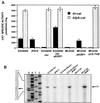Transcriptional regulation of the orf19 gene and the tir-cesT-eae operon of enteropathogenic Escherichia coli
- PMID: 11292802
- PMCID: PMC99499
- DOI: 10.1128/JB.183.9.2823-2833.2001
Transcriptional regulation of the orf19 gene and the tir-cesT-eae operon of enteropathogenic Escherichia coli
Abstract
To establish an intimate interaction with the host epithelial cell surface, enteropathogenic Escherichia coli (EPEC) produces Tir, a bacterial protein that upon translocation and insertion into the epithelial cell membrane constitutes the receptor for intimin. The tir gene is encoded by the locus for enterocyte effacement (LEE), where it is flanked upstream by orf19 and downstream by the cesT and eae genes. With the use of a series of cat transcriptional fusions and primer extension analysis, we confirmed that tir, cesT, and eae form the LEE5 operon, which is under the control of a promoter located upstream from tir, and found that the orf19 gene is transcribed as a monocistronic unit. We also demonstrated that the LEE-encoded regulator Ler was required for efficient activation of both the tir and the orf19 promoters and that a sequence motif located between positions -204 and -157 was needed for the Ler-dependent activation of the tir operon. Sequence elements located between positions -204 and -97 were determined to be required for the differential negative modulatory effects exerted by unknown regulatory factors under specific growth conditions. Upon deletion of the upstream sequences, the tir promoter was fully active even in the absence of Ler, indicating that tir expression is subject to a repression mechanism that is counteracted by this regulatory protein. However, its full activation was still repressed by growth in rich medium or at 25 degrees C, suggesting that negative regulation also occurs at or downstream of the promoter. Expression of orf19, but not of the tir operon, became Ler independent in an hns mutant strain, suggesting that Ler overcomes the repression exerted by H-NS (histone-like nucleoid structuring protein) on this gene.
Figures








Similar articles
-
Interaction of Ler at the LEE5 (tir) operon of enteropathogenic Escherichia coli.Infect Immun. 2003 Jan;71(1):384-92. doi: 10.1128/IAI.71.1.384-392.2003. Infect Immun. 2003. PMID: 12496188 Free PMC article.
-
CesT is a multi-effector chaperone and recruitment factor required for the efficient type III secretion of both LEE- and non-LEE-encoded effectors of enteropathogenic Escherichia coli.Mol Microbiol. 2005 Sep;57(6):1762-79. doi: 10.1111/j.1365-2958.2005.04802.x. Mol Microbiol. 2005. PMID: 16135239
-
Enteropathogenic Escherichia coli translocated intimin receptor, Tir, requires a specific chaperone for stable secretion.Mol Microbiol. 1999 Sep;33(6):1162-75. doi: 10.1046/j.1365-2958.1999.01558.x. Mol Microbiol. 1999. PMID: 10510231
-
Intimin and the host cell--is it bound to end in Tir(s)?Trends Microbiol. 2001 May;9(5):214-8. doi: 10.1016/s0966-842x(01)02016-9. Trends Microbiol. 2001. PMID: 11336837 Review.
-
Enteropathogenic Escherichia coli: cellular harassment.Curr Opin Microbiol. 1999 Feb;2(1):83-8. doi: 10.1016/s1369-5274(99)80014-9. Curr Opin Microbiol. 1999. PMID: 10047555 Review.
Cited by
-
Transcriptional inhibitor of virulence factors in enteropathogenic Escherichia coli.Antimicrob Agents Chemother. 2005 Oct;49(10):4101-9. doi: 10.1128/AAC.49.10.4101-4109.2005. Antimicrob Agents Chemother. 2005. PMID: 16189086 Free PMC article.
-
Dynamics of expression and maturation of the type III secretion system of enteropathogenic Escherichia coli.J Bacteriol. 2014 Aug;196(15):2798-806. doi: 10.1128/JB.00069-14. Epub 2014 May 16. J Bacteriol. 2014. PMID: 24837293 Free PMC article.
-
Hfq affects the expression of the LEE pathogenicity island in enterohaemorrhagic Escherichia coli.Mol Microbiol. 2009 Aug;73(3):446-65. doi: 10.1111/j.1365-2958.2009.06781.x. Epub 2009 Jun 29. Mol Microbiol. 2009. PMID: 19570135 Free PMC article.
-
EutR is a direct regulator of genes that contribute to metabolism and virulence in enterohemorrhagic Escherichia coli O157:H7.J Bacteriol. 2013 Nov;195(21):4947-53. doi: 10.1128/JB.00937-13. Epub 2013 Aug 30. J Bacteriol. 2013. PMID: 23995630 Free PMC article.
-
Gene Activation through the Modulation of Nucleoid Structures by a Horizontally Transferred Regulator, Pch, in Enterohemorrhagic Escherichia coli.PLoS One. 2016 Feb 22;11(2):e0149718. doi: 10.1371/journal.pone.0149718. eCollection 2016. PLoS One. 2016. PMID: 26901318 Free PMC article.
References
-
- Abe A, de Grado M, Pfuetzner R A, Sánchez-SanMartín C, DeVinney R, Puente J L, Strynadka N C J, Finlay B B. Enteropathogenic Escherichia coli translocated intimin receptor, Tir, requires a specific chaperone for stable secretion. Mol Microbiol. 1999;33:1162–1174. - PubMed
-
- Atlung T, Ingmer H. H-NS: a modulator of environmentally regulated gene expression. Mol Microbiol. 1997;24:7–17. - PubMed
-
- Brosius J. Plasmid vectors for the selection of promoters. Gene. 1984;27:151–160. - PubMed
-
- Bustamante V H, Santana F J, Calva E, Puente J L. Transcriptional regulation of type III secretion genes in enteropathogenic Escherichia coli (EPEC): Ler antagonizes H-NS-dependent repression. Mol Microbiol. 2001;39:664–677. - PubMed
Publication types
MeSH terms
Substances
LinkOut - more resources
Full Text Sources
Other Literature Sources
Molecular Biology Databases
Miscellaneous

